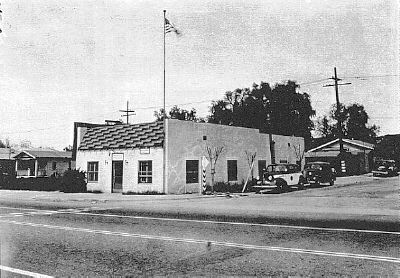By Leon Worden November 8, 1996
Leon Worden is a Santa Clarita resident. His commentary appears Wednesdays.
ipping past it at 50 mph on your way to the San Fernando Valley, you wouldn't know that the unobtrusive building at 6th Street and San Fernando Road was anything special. The bars on the back windows appear to be nothing more than a sign of the times.
Z
What those bars really are is a relic of days gone by.
Many of Old Newhall's historic buildings still stand. It's just that few if any clues remain of their former uses. The old Newhall jail, for instance, is now a flower shop. William S. Hart's American Theater is the American Legion Hall. Ye Olde Courthouse is an office building and video outlet.
This Friday, November 8th, in a 10:00 a.m. ceremony at the SCV Sheriff's Station, Sheriff Sherman Block and his deputies will celebrate the 70th anniversary of the day the county gendarmes established their local presence at 6th and San Fernando, in a building that now houses an automotive supply service.
It was July of 1926 when our county supervisors decided that the practice of sending deputies out on horseback from downtown Los Angeles to chase down gun-toting bandits in remote regions like Newhall wasn't working anymore. Too often, suspects escaped during the long haul back. The supervisors voted to create several substations, one of which would oversee the vast northwestern region from Chatsworth to the Antelope Valley.
 Substation No. 6 was set up on San Fernando Road, then known as Spruce Street, in a structure that had been a private residence of local hotelier Albert Swall. A home at Sixth Street and Railroad Avenue was used temporarily while the Swall home was being readied. (Heavily damaged in the 1994 Northridge earthquake, the original Railroad Avenue structure stands at a slant today.)
Substation No. 6 was set up on San Fernando Road, then known as Spruce Street, in a structure that had been a private residence of local hotelier Albert Swall. A home at Sixth Street and Railroad Avenue was used temporarily while the Swall home was being readied. (Heavily damaged in the 1994 Northridge earthquake, the original Railroad Avenue structure stands at a slant today.)
Deputy J.E.B. Stewart came up from L.A. to open the new substation on August 26, 1926. Signal editor Dad Thatcher writes, "The station will be open all the time with two men on duty. The force includes deputies Howard, Fox, Ernst, Stockwell, Knus, Nester and Aikens. The new officers are a jolly bunch of fellows, and very pleasant to meet — unless you happen to be transacting your business with them from the wrong end of a sawed-off shotgun." Cells were added two years later, but the old Newhall jail, built in 1906 at Eleventh and Spruce, housed prisoners through 1939.
Deputies handled criminal business. Lesser matters were relegated to constables, who had policed the Santa Clarita Valley since 1878. Constables were publicly elected until 1913, when Los Angeles became a chartered county and local law enforcement became the Sheriff's responsibility. Constables were made ex-officio deputies, and they still served subpoenas and acted as Justice Court bailiffs after 1936, when the Constabulary was absorbed into county civil service.
Newhall Station served the sleepy Soledad Township and Newhall area for over four decades. Former Santa Clarita mayor George Pederson, assigned to the station in 1965 as a sergeant, remembers: "The biggest problem they had in the old days was hobos sleeping by the train tracks." In 1965, Pederson recalls, the station employed a total of only 30 people.
Today the SCV Sheriff's Station employs 162 sworn officers and 26 civilians. The growth of the valley in the late 1960s and early 1970s necessitated a move to bigger quarters. The Sheriffs moved to the then-new Civic Center in 1972 and bade the old Newhall Station a fond farewell.
It was good timing for The Signal, which had suffered a fire in its production office in 1969. No sooner had the Sheriffs moved out than The Signal moved in. The paper used the building until 1986, when it too needed more breathing room and moved to Creekside Road in Valencia.
The highlight of this Friday's anniversary celebration will be the unveiling of a beautiful scrapbook compiled by Sheriff's Advisory Committee member Estelle Foley, who has spent most of the year assembling the complete history of the SCV Station and its personnel. Lt. Robert Elson calls it a "labor of love," and indeed it is. Bound copies of Estelle's book will be available for $20, and it is a work that no law enforcement supporter or history buff will want to forego.
©1996 LEON WORDEN — ALL RIGHTS RESERVED

